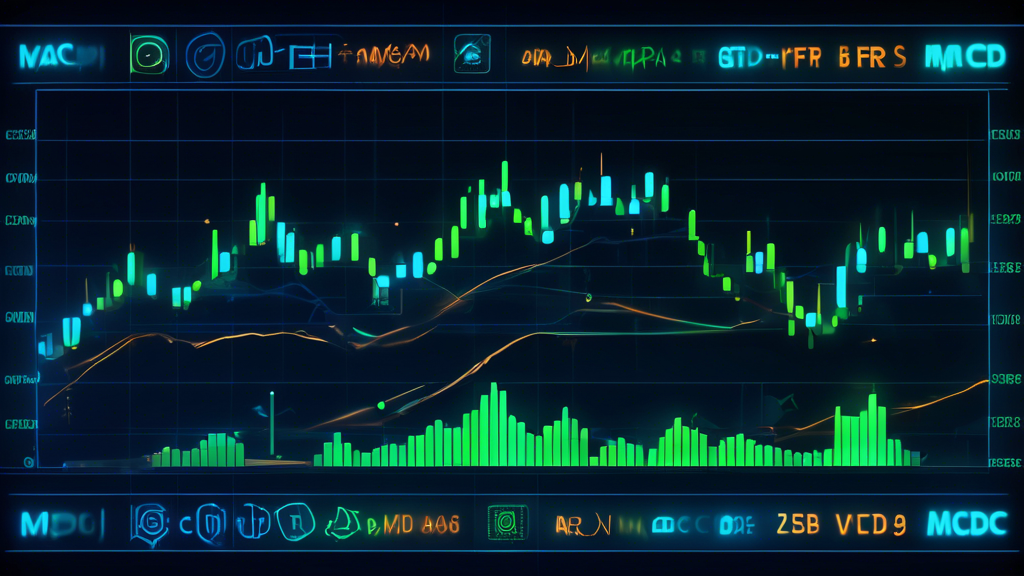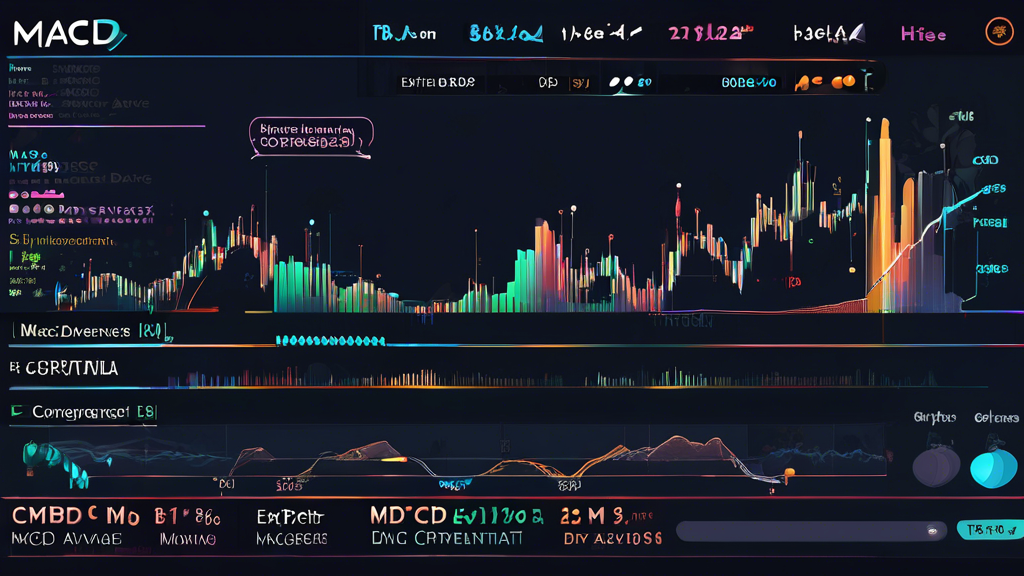In the ever-evolving world of financial markets, trading has emerged as a popular method for…
Understanding Crypto Trading with MACD: A Comprehensive Guide

In the fast-paced world of cryptocurrency, understanding the nuances of trading is crucial for both novice and experienced investors. Crypto trading involves buying, selling, and exchanging digital currencies in a market characterized by high volatility and rapid price fluctuations. As traders seek to maximize their returns, various technical indicators become invaluable tools in analyzing market trends and making informed decisions. One such powerful indicator is the Moving Average Convergence Divergence (MACD), a widely-used momentum oscillator that helps traders identify potential buy and sell signals based on price trends.
This comprehensive guide will delve into the intricacies of crypto trading and the pivotal role that MACD plays in formulating effective trading strategies. By unpacking the various components of MACD, including the MACD line, Signal line, and Histogram, we will equip you with the knowledge needed to calculate, interpret, and apply MACD in real-world trading scenarios.
Whether you’re looking to enhance your trading skillset or simply want to understand how MACD can improve your decision-making process, this guide offers practical applications, case studies, and crucial insights into avoiding common pitfalls. Ultimately, you will gain a solid grounding in crypto trading with MACD, empowering you to integrate this potent tool into your trading practices and navigate the cryptocurrency market with greater confidence. Explore further resources at successful trading platforms and analytical tools to enrich your learning experience and stay ahead in the ever-evolving crypto landscape.
1. Introduction to Crypto Trading and MACD
Definition of Crypto Trading
Crypto trading refers to the buying and selling of cryptocurrencies on various trading platforms. Unlike traditional stock markets, crypto trading operates 24/7, allowing traders to take advantage of price fluctuations at any time. Key components of crypto trading include:
- Cryptocurrencies: Digital currencies like Bitcoin, Ethereum, and Litecoin.
- Exchanges: Platforms such as Binance, Coinbase, and Kraken where transactions occur.
- Trading pairs: Combinations of two currencies (e.g., BTC/USD) used to facilitate trading.
- Market orders: Buying or selling at the current market price.
- Limit orders: Setting specific price points for buying or selling assets.
Overview of MACD (Moving Average Convergence Divergence)
The Moving Average Convergence Divergence (MACD) is a popular technical analysis tool used by traders to identify trend changes and momentum in the crypto markets. Developed by Gerald Appel in the late 1970s, the MACD oscillates, which helps traders spot potential buy and sell signals based on different market conditions. The primary components of MACD are:
- MACD Line: The difference between the 12-day and 26-day exponential moving averages (EMAs).
- Signal Line: A 9-day EMA of the MACD line that serves as a trigger for buy and sell decisions.
- Histogram: The graphical representation of the difference between the MACD line and the Signal line, indicating strength and duration of trends.
Importance of MACD in Trading Strategies
Integrating MACD into crypto trading strategies is essential due to its ability to provide insights into market momentum and trend reversals. Below are key reasons why MACD is important for traders:
- Trend Identification: MACD helps traders recognize whether a market is in a bullish or bearish phase.
- Momentum Measurement: The histogram visualizes the strength of the trend, which assists in decision-making.
- Timing Entries and Exits: The crossover signals between the MACD and Signal line allow traders to time their market entries and exits more effectively.
- Versatility: MACD can be used across various time frames and is applicable in different trading styles, from day trading to long-term investing.
Getting Started with MACD in Crypto Trading
For traders looking to incorporate MACD into their trading routine, it’s vital to understand the essential settings and how they can be adapted to specific trading styles. Here are some steps to get started:
- Choose a Trading Platform: Use trading platforms that provide access to MACD indicators, such as TradingView or MetaTrader.
- Set Up the Indicator: Most platforms come pre-installed with the MACD indicator. Adjust the default settings if necessary.
- Analyze Historical Data: Study past price movements alongside the MACD signals to understand its effectiveness in various market conditions.
- Combine with Other Indicators: Enhance analysis by using MACD alongside other indicators like RSI (Relative Strength Index) or Bollinger Bands.
By becoming familiar with crypto trading fundamentals and the MACD indicator, traders can leverage these tools to create well-informed trading strategies and improve their overall performance in the crypto markets.

How MACD Works in Crypto Trading
Explanation of MACD Components
The Moving Average Convergence Divergence (MACD) is a vital tool in crypto trading, and it consists of three main components:
- MACD Line: This is the difference between the 12-day and 26-day exponential moving averages (EMAs). When the MACD line crosses above the signal line, it indicates a potential buy signal, while a downward crossover may indicate a sell signal.
- Signal Line: A 9-day EMA of the MACD line, the signal line helps confirm buy or sell signals. Traders often use the signal line to identify potential trend reversals.
- Histogram: This shows the difference between the MACD line and the signal line. A growing histogram indicates increasing momentum, while a shrinking histogram may suggest weakening momentum.
Calculating MACD: A Step-by-Step Guide
Understanding how to calculate the MACD is crucial for effective trading. Here’s a simple breakdown of the calculation steps:
1. **Calculate the 12-Day EMA:**
– Start with the simple moving average (SMA) for the first 12 days.
– Multiply the most recent closing price by (2 / (12 + 1)).
2. **Calculate the 26-Day EMA:**
– Start with the SMA for the first 26 days.
– Multiply the most recent closing price by (2 / (26 + 1)).
3. **Determine the MACD Line:**
– Subtract the 26-day EMA from the 12-day EMA.
4. **Calculate the Signal Line:**
– Use the MACD line’s EMA over a 9-day period.
5. **Generate the Histogram:**
– Subtract the signal line from the MACD line.
For a hands-on calculator, you can visit [Investopedia’s MACD calculator](https://www.investopedia.com/calculator/macd-calculator).
Interpreting MACD Signals in Crypto Markets
Interpreting MACD in crypto trading involves understanding the signals it provides. Here are some common interpretations:
- Crossover Signals: When the MACD line crosses above the signal line, it is often interpreted as a bullish signal (indicating a potential buy). Conversely, when it crosses below, it may indicate a bearish signal (suggesting a potential sell).
- Divergence: If the price of a cryptocurrency is making new highs while the MACD is not, this could signal a reversal in trend. Conversely, if the price is making new lows while the MACD is increasing, this could suggest an impending uptrend.
- Zero Line Cross: When the MACD line crosses above the zero line, it indicates that the shorter-term EMA is above the longer-term EMA, often signifying a bullish trend. Crossing below the zero line indicates a bearish trend.
- Histogram Analysis: A rising histogram indicates increasing upward momentum, while a declining histogram suggests decreasing momentum. Traders often look for the histogram to change direction as a sign of a potential trend shift.
Practical Example of MACD Interpretation
To see MACD in action, consider the following trade scenario:
– A trader monitors a cryptocurrency, such as Bitcoin, and notices the MACD line crosses above the signal line (bullish crossover).
– The histogram starts increasing, confirming upward momentum.
– The trader takes a long position, expecting further price increases.
– Later, the MACD line crosses back below the signal line, prompting an exit from the position as momentum shifts.
Additional Resources
To deepen your understanding of MACD and its applications in crypto trading, consider checking out these resources:
Understanding how MACD works in crypto trading equips traders with the necessary skills to interpret charts effectively and make informed trading decisions. By combining MACD signals with other indicators and market analysis, traders can enhance their strategies and potentially improve their chances of success in the volatile crypto markets.

Practical Applications of MACD in Crypto Trading
Strategies for Using MACD Effectively
Implementing MACD in your crypto trading strategy can significantly enhance your decision-making process. Here are some effective strategies:
- Crossover Strategy: This is the most widely used MACD strategy, which involves trading based on the crossover between the MACD line and the signal line. A bullish signal is indicated when the MACD line crosses above the signal line, suggesting a buying opportunity, while a bearish signal occurs when the MACD line crosses below the signal line, indicating a selling opportunity.
- MACD Divergence: Look for divergences between the MACD and the asset’s price. For example, if the price is making new highs while the MACD is making lower highs, it could indicate a potential trend reversal. This strategy can be used to identify entry and exit points effectively.
- Histogram Analysis: Analyze the MACD histogram to gauge the strength of a trend. A growing histogram suggests that the trend is gaining momentum, while a shrinking histogram indicates that the momentum is waning. This can be a signal to either enter a position or exit one.
- Combining with Other Indicators: Using MACD alongside other technical indicators like RSI (Relative Strength Index) or moving averages can provide a more robust trading strategy. For instance, if both MACD shows a bullish crossover and RSI indicates that the market is not overbought, it strengthens the case for a buy.
Case Studies: Successful Trading Examples Using MACD
Real-world examples can provide valuable insights into how MACD can be applied successfully in crypto trading. Below are a couple of case studies:
| Case Study | Crypto Asset | MACD Signal | Outcome |
|---|---|---|---|
| 1 | Bitcoin (BTC) | Bullish Crossover in April 2023 | Successful trade with a 30% gain over 2 months |
| 2 | Ethereum (ETH) | Bearish Divergence in July 2023 | Successful exit, preventing a 25% loss |
In the Bitcoin case, traders who acted on the MACD bullish crossover were able to capitalize on the ensuing price increase. Conversely, the bearish divergence in Ethereum showcases how MACD can help avoid significant losses. Utilizing such case studies to inform your own trading strategy can lead to more educated and profitable decisions.
Common Pitfalls and How to Avoid Them
While MACD can be a powerful tool in crypto trading, traders should be aware of common pitfalls that can lead to adverse outcomes:
- Over-Reliance on MACD Signals: While MACD provides critical insights, it’s essential not to rely solely on MACD signals. Always confirm with additional indicators and market analysis.
- Ignoring Market Conditions: MACD can produce false signals in highly volatile markets. Be sure to assess general market trends, news, and sentiment before acting on MACD signals.
- Not Adjusting for Time Frame: Different time frames can yield different signals. What’s accurate on a short time frame may not hold true on a longer one. Always adjust your analysis according to your trading strategy’s time frame.
- Neglecting Risk Management: Always use proper risk management strategies, including setting stop-loss orders to cap losses and protect your capital, regardless of what the MACD indicates.
In summary, understanding practical applications of MACD in crypto trading requires a blend of strategies, real-world case studies, and awareness of common pitfalls. By effectively leveraging these insights, traders can enhance their trading success using MACD’s strengths while steering clear of common mistakes. Always remember to combine MACD with other analytical tools for more reliable trading decisions. For further details on trading strategies and insights, consider visiting resources like Investopedia and CoinDesk for the latest updates and strategies in crypto trading and MACD.

4. Practical Applications of MACD in Crypto Trading
Understanding the practical applications of the MACD (Moving Average Convergence Divergence) indicator is crucial for successful crypto trading. This powerful tool not only helps clarify market momentum but also assists traders in making informed decisions based on historical price behaviors.
Strategies for Using MACD Effectively
- Trend Following: Use MACD to identify the overall trend. When the MACD line crosses above the signal line, it’s often seen as a bullish signal, indicating a potential upward trend. Conversely, a MACD line crossing below the signal line suggests a bearish trend.
- Macd Diverge: Look for divergence between the price and MACD. If the price is making new highs while the MACD is making lower highs (or vice versa), it may indicate a potential reversal.
- Signal Line Crosses: Monitor the interaction between the MACD line and the signal line. A crossover can signal entry and exit points for trades. For instance, entering when the MACD crosses above the signal line can be an effective strategy in a bullish market.
- Combine with Other Indicators: Utilize MACD alongside other technical indicators, such as RSI (Relative Strength Index) or Bollinger Bands, to corroborate trade decisions. This multilayered analysis can improve the robustness of trading signals.
Case Studies: Successful Trading Examples Using MACD
| Example | Trade Entry Point | Trade Exit Point | Outcome |
|---|---|---|---|
| BTC/USD – Bullish Trend | MACD line crossed above the signal line | MACD line crossed below the signal line | Profit of 20% over 3 weeks |
| ETH/USD – Bearish Divergence | Price made a new high while MACD made a lower high | Sold as the MACD line crossed below the signal line | Profit of 15% from short position |
| LTC/USD – False Breakout | MACD did not confirm new price highs | Exited position as MACD showed downward momentum | Avoided loss of 10% |
Common Pitfalls and How to Avoid Them
- Overreliance on MACD: While MACD is a valuable indicator, relying solely on it can lead to misinterpretations. Always cross-check with other indicators and fundamental analysis.
- Ignoring Market Conditions: MACD tends to perform poorly in choppy or sideways markets. Always assess the overall market conditions before making trading decisions based on MACD signals.
- Length of Time Frame: Consider the time frame you’re trading in. Short-term traders may find shorter MACD settings (like 5 and 10) more beneficial while long-term investors should consider longer settings (like 12 and 26).
- Emotional Trading: Avoid making impulsive decisions based on MACD signals alone. It’s important to have a clear trading plan that includes exit strategies and risk management.
Additional Resources for Further Learning on Crypto Trading and MACD
Enhance your understanding of crypto trading and MACD with the following resources:
- Investopedia – Moving Average Convergence Divergence (MACD)
- TradingView – Charting Tools and Community
- Binance – Understanding Trading Strategies
- YouTube – Educational Videos on MACD and Trading
By integrating these strategies and resources into your trading practice, you can leverage the power of MACD to navigate the volatile realm of crypto trading effectively.
In conclusion, the Moving Average Convergence Divergence (MACD) indicator is an invaluable tool for both novice and experienced crypto traders. Its components—the MACD line, Signal line, and Histogram—provide insights that can help traders identify potential buy and sell signals within the inherently volatile crypto market. By understanding and effectively calculating these components, traders can make more informed decisions, enhancing their strategies and potentially improving their profit margins.
Throughout this guide, we’ve explored practical applications of MACD, offering strategies that can be tailored to individual trading styles as well as real-world case studies that illustrate the successful application of this indicator. However, it is essential to remain mindful of the common pitfalls associated with MACD, such as over-relying on signals or failing to incorporate broader market analysis. By recognizing these challenges, traders can better navigate the crypto landscape.
As you advance your trading journey, consider integrating MACD into your trading practices. This tool can complement other indicators and strategies, enabling you to create a more comprehensive trading plan. Continuous learning is key in the fast-evolving world of cryptocurrency; therefore, we encourage you to explore additional resources and educational materials. Websites like Investopedia’s MACD guide and trading communities on platforms such as Reddit or TradingView can provide further insights and peer support, deepening your understanding and application of both crypto trading and MACD.
By embracing MACD and utilizing it wisely, traders not only enhance their analytical skills but also position themselves for greater success in navigating the exciting yet unpredictable realm of cryptocurrency.





